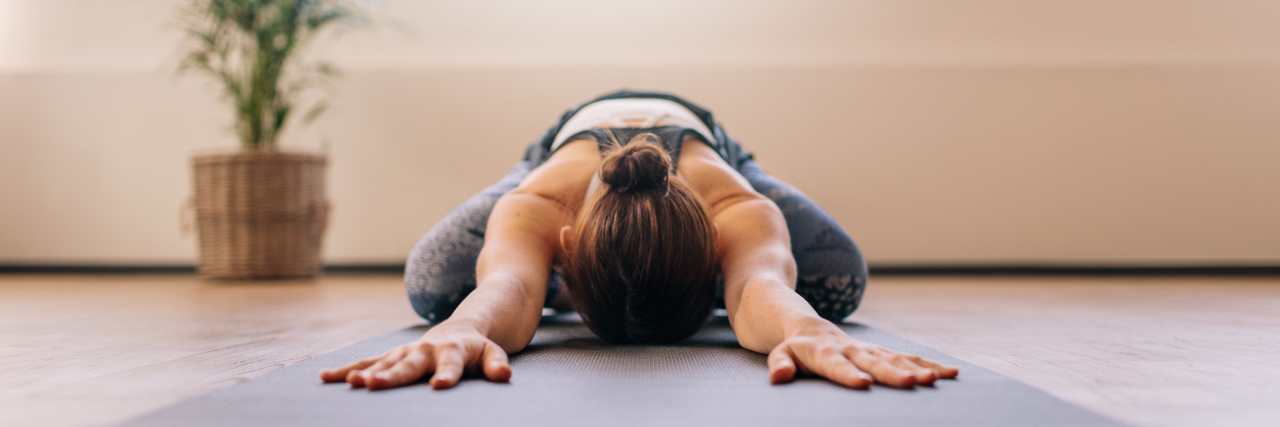How Yoga Taught Me I Am Capable as a Woman With a Disability
I stood barefoot on the floor of the high school wrestling room, my leg extended in a yoga pose. The pressures of the world around me slowly faded. My breath began to fall steadily. The deafening pop music surrounding me seemed to meld into the background, leaving me with only one focus — myself. For the first time in years, I felt at peace, and for the first time in my life, I felt content with my body and its capabilities.
I was born with cerebral palsy, which caused me a spate of seemingly irreversible body image issues. Although the condition has physically affected me extremely mildly, its emotional effects have lingered throughout my life. Even as a young child, I could sense that I was not as athletically talented as my peers, and I longed to be able to keep up with their physical pursuits. However, my stiff muscles and slightly awkward gait prevented me from excelling at sports, which eventually led me to despise the culprit of my lack of coordination — my disabled body.
Surprisingly, my lack of athletic prowess did not prevent me from trying (and ultimately discarding) nearly every physical activity imaginable. Like other little girls, I played T-ball. I took ballet lessons, played basketball, attended gymnastics camp, spent years learning how to swim, and I even attempted cheerleading. Despite my heavy involvement in physical activities, however, I felt ashamed of my lack of athleticism. I constantly worried that as a teammate, I was holding my able-bodied peers back from their full potential and that as a person with a disability, I could never be perceived as their equal. Every time I competed alongside my able-bodied peers, a palpable tension seemed to hang in the air — an unspoken sense that my teammates would be more successful without my inherent clumsiness and my propensity to lose games.
By high school, my struggle to find a form of exercise that wouldn’t hold anyone else back from success had transformed into a complicated relationship with my self-image. I felt as though my body was cumbersome, burdensome and taboo in a culture in which able-bodied athletes are idolized and winning is everything. I wished my disability didn’t exist and fervently attempted to hide it behind ridiculous excuses that I had “pushed myself too hard” or “twisted my ankle.” I constantly felt like I needed an acceptable justification for my lackluster performance in physical education classes and steadfastly convinced myself that if anyone discovered my disability, my peers would ostracize me.
In the middle of my ninth grade year, the Dance and Fitness PE teacher at my school was looking to recruit a few girls from my general PE class, and she asked me and three other girls to speak with her about the possibility of transferring into her class. I was immediately struck with terror over the sheer possibility of stiffly dancing in front of my peers with no way to hide my disability, but the other girls accepted her offer immediately, and as a peer-pressure-prone 14-year-old girl, I reluctantly agreed to join the class. I assumed that at the very least, it would be a welcome reprieve from poorly-executed push-ups and failed attempts at throwing a football, so I anxiously forged ahead.
I was surprised when, under a week into the new class, my PE teacher led us to the school’s wrestling room for a yoga lesson. As she instructed us to remove our shoes and line up, I worried my cerebral palsy would become glaringly obvious. I had never tried yoga in my life, but I assumed my entire PE class would fixate on me, wondering why I could not seem to execute the poses, and consequently, I would become irreparably self-conscious.
I could not have been more wrong.
As the music began and we transitioned into our first pose, I discovered that the stretch felt easy, controlled but completely relaxed. My wildly pounding heart began to slow to a steady rhythm as I realized I was not focused on anyone else’s reactions to my body; I was solely focused on the art of yoga itself. I felt centered, as if no one else existed in that moment. I felt untouchable, as if my self-consciousness had gradually dissipated from my mind. For the first time in my life, I was competing against no one but myself. I gradually discovered the strength and beauty of my disabled body as it seemingly effortlessly glided from pose to pose. I realized that in yoga, I couldn’t hold anyone but myself back from success, and I was determined to embrace my unlimited potential. At last, I discovered I was physically capable — strong, enduring, and graceful — with my cerebral palsy, not despite it. At last, I felt equal to my able-bodied peers.
To this day, yoga is the only exercise I have ever truly enjoyed. Yoga has shown me that my body has never been “broken,” that I am whole, even with my physical limitations. It has allowed me to discover my inherent physical strength and beauty — an innate power that transcends disability. It has redefined my self-perception by allowing me to highlight my capabilities — without comparing them against anyone else’s. Most importantly, yoga has allowed me to wholeheartedly embrace myself, cerebral palsy and all. With a yoga mat, a little determination, and a resolution to focus on no one but myself, I know that I am — and always have been — an equal.
This story originally appeared on Hello Giggles.
Getty image by Jacob Lund.

